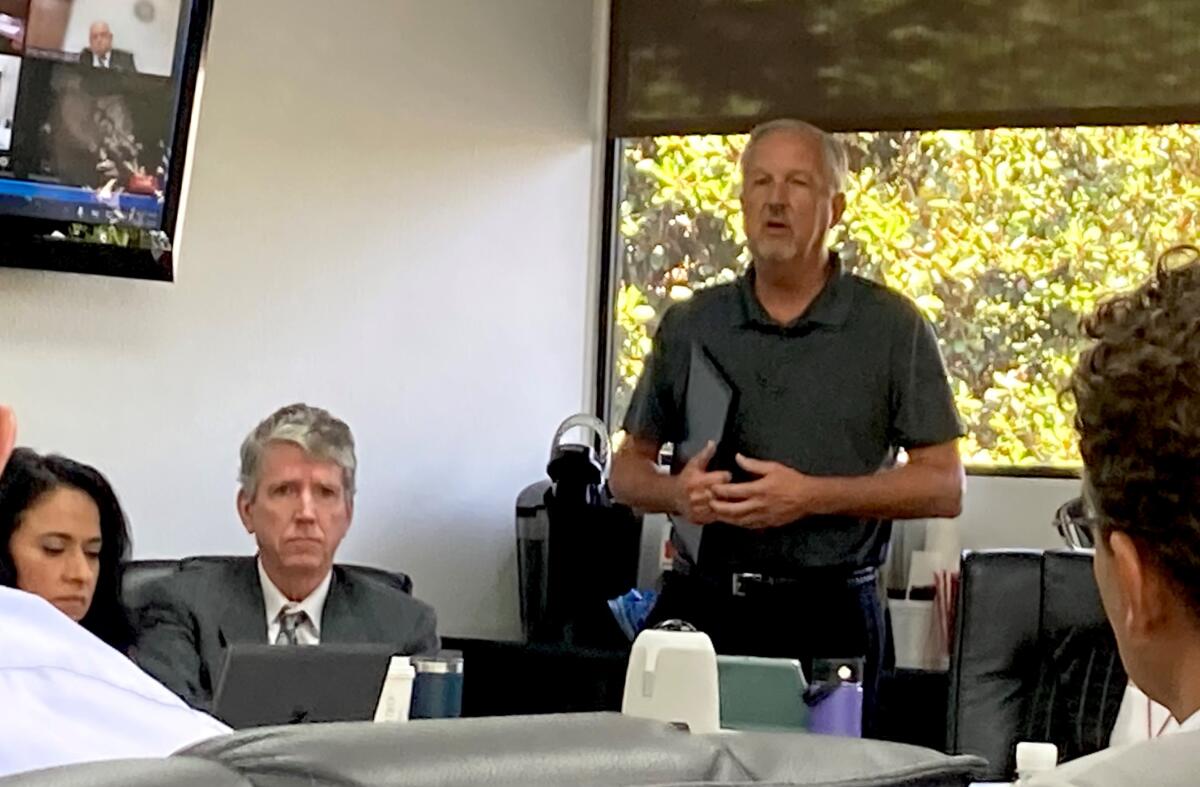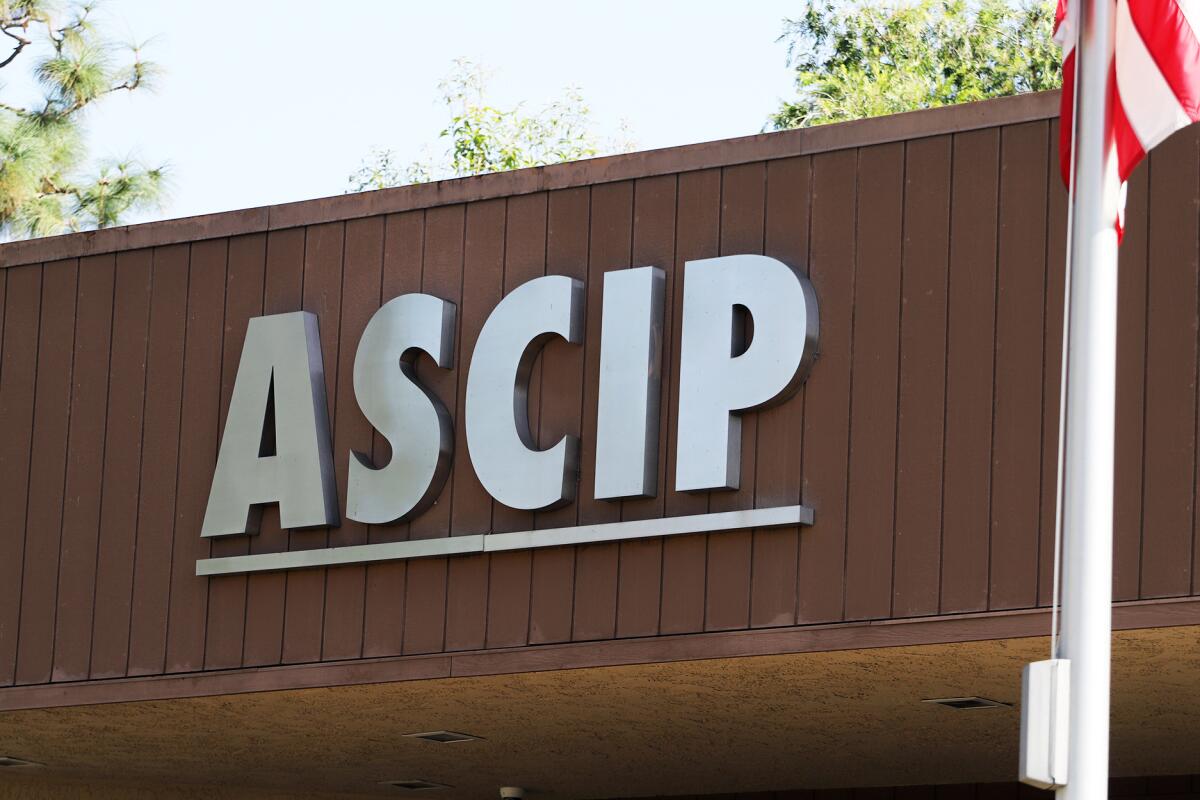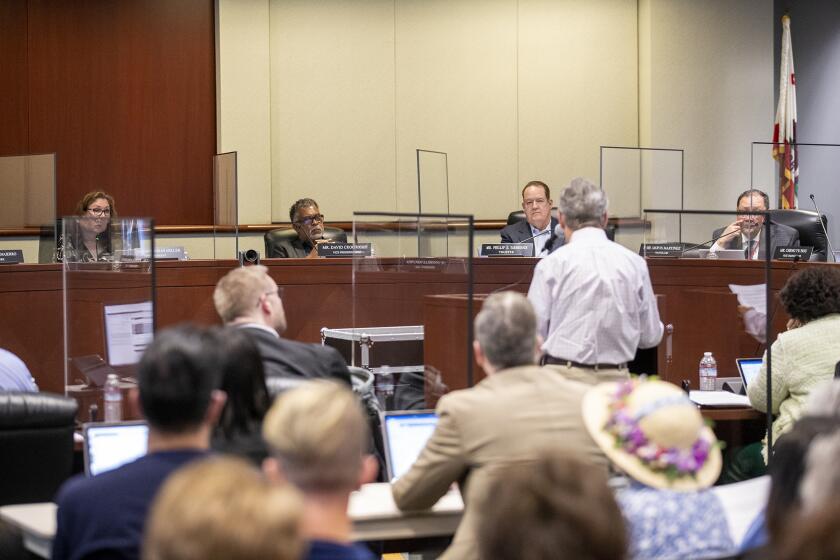2 retired Rancho Santiago CCD employees have deep moorings in ASCIP risk pool

- Share via
As Rancho Santiago Community College District stakeholders begin to probe the district’s decades-long relationship with the Alliance of Schools for Cooperative Insurance Programs, an insurance risk pool operator, the names of two now-retired administrators keep popping up.
John Didion, former vice chancellor of human resources, and former Vice Chancellor of Fiscal Services Peter Hardash, not only oversaw matters related to insurance and risk management but have ties to the Cerritos-based joint powers authority that date back far longer than the 27 years Rancho Santiago has been a policyholder.
Although Didion and Hardash retired in 2016 and 2021, respectively, the two former administrators continue their affiliation with ASCIP to this day, serving on the board of Captive Insurance for Public Agencies, Ltd. (CIPA), a nonprofit corporation and subsidiary formed by ASCIP in 2005, according to the organization’s incorporating documents.
These board positions are unpaid, as they were during the several years both men served on the CIPA board at the same time they worked for the district, recommending and directing hundreds of millions of dollars of insurance business to ASCIP and its subsidiary.
Didion and Hardash did not return calls requesting comments on the district’s relationship with ASCIP.
In January 2023 retired Rancho Santiago CCD Professor Barry Resnick reached out to the Daily Pilot, claiming Didion and Hardash had been corporate officers of a vendor named CIPA that received nearly $8 million in public funds, from 2008 to 2021, but whose existence was unknown by elected officials.

Resnick had heard about CIPA from a colleague and learned Didion was working as a managing director for the company. He called ASCIP directly, asking for confirmation and was forwarded to an attorney who, after much back and forth, confirmed Didion’s position, according to Resnick.
While this double duty was occurring — as Hardash and Didion’s signatures appeared on invoices cut to the JPA for bond construction insurance handled by CIPA, according to records obtained by the Pilot — it appeared neither administrator directly disclosed his board service to elected officials at Rancho Santiago.
“I asked a few trustees, and they didn’t know. It was concerning,” Resnick said. “It’s like [Didion and Hardash] were working for two masters, but the one they have the fiduciary responsibility to is the district.”
John Hanna has served more than two decades on the board of Rancho Santiago CCD, yet he acknowledged in an interview with the Pilot in 2023 he had almost no awareness of Hardash’s connection to ASCIP or CIPA.
“I didn’t know at the time — I didn’t know at all,” he said. “[Hardash] was involved in a lot of discussions. He’d be there in closed session when this stuff was talked about, and he’d make some reports about some issues, and maybe ASCIP would be involved, but I wasn’t aware of his relationship with ASCIP.”

Hardash, who voting records indicate is 68, was just 24 years old and working at Downey Unified School District in 1980, when he and 45 other Los Angeles County administrators helped form the Alliance of Schools for Cooperative Insurance Programs as a joint-purchase program.
ASCIP officials recount the tale of his role in the JPA’s formation in a 2014-15 annual report celebrating its 35-year anniversary and featuring comments and a photo of him.
Today, ASCIP operates a risk pool that comprises 134 members and offers employee medical, dental and vision, workers’ compensation and property and liability coverage, according to its website.
The joint powers authority is led by a chief executive officer and governed by a 13-member executive committee of administrators from California K-12 and community college districts and public charter schools who are members.
ASCIP CEO Fritz Heirich, through the JPA’s attorney Robert J. Feldhake, declined multiple requests made by the Pilot in 2023 and 2024 to be interviewed about CIPA and its board of directors.
Exactly when Hardash joined ASCIP’s Executive Committee is unclear, according to conflicting documentation provided by Feldhake in response to two separate public records requests submitted by the Pilot.
One document indicates Hardash joined the board in 1995, while another shows him as a member in 1992. He served on the Executive, Claims and Coverage and Finance committees, as well as a Nominating Committee that selects leaders from among ASCIP’s membership for governance positions.
For decades, the district provided retirees with the same health plans as active employees. A lawsuit argues that required enrollment in Medicare and a Medicare Advantage Plan constitutes a breach of contract.
Didion, now 70, first joined ASCIP’s board in 1994 and was serving as chair of the Claims and Coverage Committee three years later, when he left Long Beach City College, an ASCIP member, to take a job as director of personnel for Rancho Santiago, which had no relationship with ASCIP at the time.
That all changed three months after Didion’s arrival in January 1997, when he recommended the district switch its property and liability coverage from another insurance risk pool to ASCIP, as indicated by a board meeting agenda showing the matter as a personnel item.
By 2001, the district had moved its workers’ compensation coverage to the ASCIP, according to an email on Rancho Santiago’s historic agreements with the JPA, provided by risk manager Don Maus to Chancellor Marvin Martinez in 2020 and reviewed by the Pilot.
Four years after that, Didion was listed as a founding director of CIPA, the Alliance of Schools for Cooperative Insurance Program’s captive insurance company domiciled in Hawaii, according to the organization’s incorporating documents.
In that capacity, he and a small cadre of administrators attended annual trips to posh resort hotels where appearances at an annual board meeting and insurance conference were punctuated by golf games, spa trips and excursions that appear on numerous expense reports paid by ASCIP and obtained by the Pilot.
Unlike ASCIP’s Executive Committee — which cannot not be populated by retirees no longer affiliated with the JPA’s member districts, according to its bylaws — CIPA board members were, until recently, able to continue their tenures indefinitely.
A policy change implemented in January of this year limits post-retirement service to just five years, according to new bylaws received by the Pilot from the JPA through a request for public records.
Didion and Hardash serve on the board to this day and still make regular pilgrimages to Hawaii, with Didion being named as CIPA’s board president this year, according to minutes from a company board meeting obtained by the Pilot.
Didion’s involvement in Captive Insurance for Public Agencies continued past his retirement from Rancho Santiago in August 2016. Six months later, he accepted a paid consulting position with CIPA, signing on as managing director at a rate of $96,000 per year — a sum he earned on top of two public school pensions amounting to $194,951 annually, according to Transparent California.
But before he retired from Rancho Santiago CCD, Didion made one more recommendation: In June 2015, he advised the district move its $22.6-million employee health coverage into ASCIP’s risk pool. The move was supported by the district’s Joint Benefits Committee, a panel Didion chaired.
Today, Rancho Santiago’s employee health account represents the district’s last tie to ASCIP. Under that program, the district was for years paying premiums to cover retirees who could have been enrolled in Medicare.
When Chancellor Martinez decided in 2021 to shift retiree coverage away from ASCIP and into Medicare, a cost-saving move for the district, Didion filed a lawsuit on behalf of a group of retirees, demanding the business remain with the JPA. He was ultimately unsuccessful.
But now the fate of that 27-year relationship hangs in the balance, as district officials on Monday will vote on whether to continue with ASCIP, and its provider Anthem, or switch to a competitor.
All the latest on Orange County from Orange County.
Get our free TimesOC newsletter.
You may occasionally receive promotional content from the Daily Pilot.





